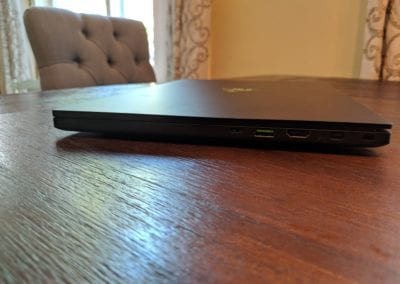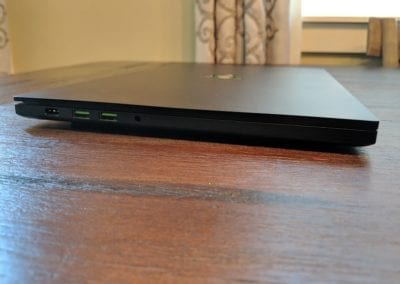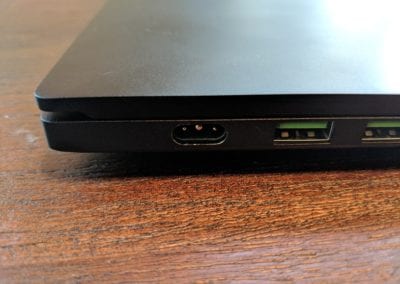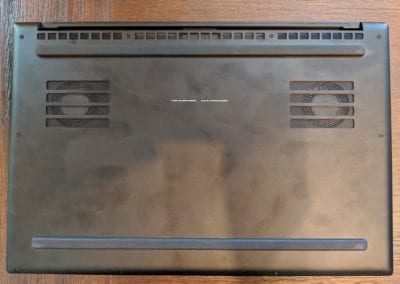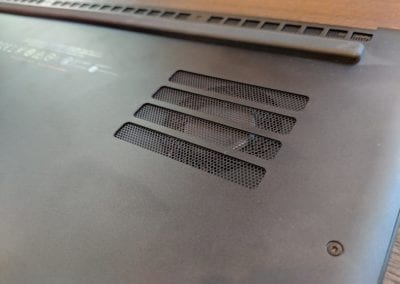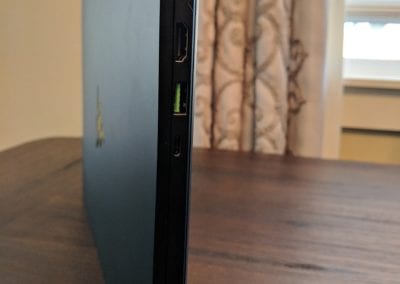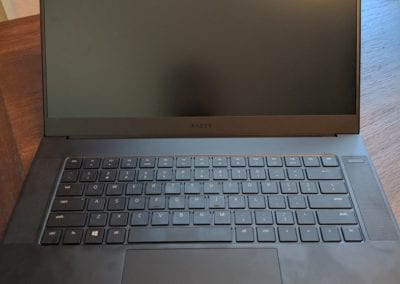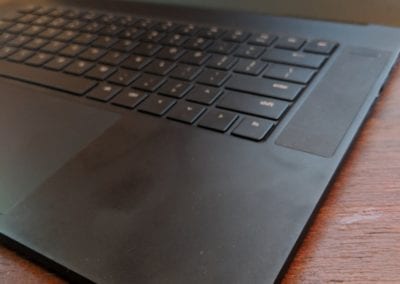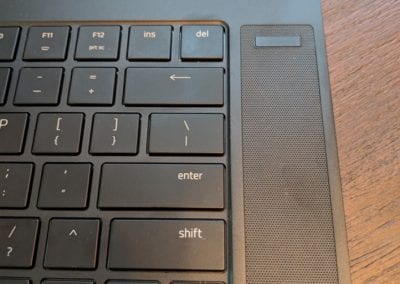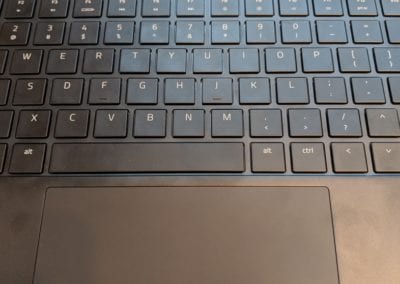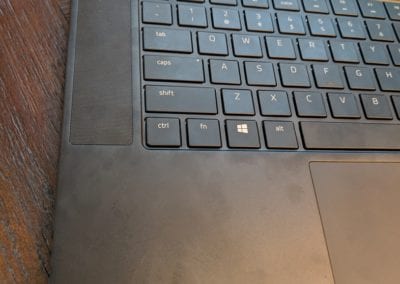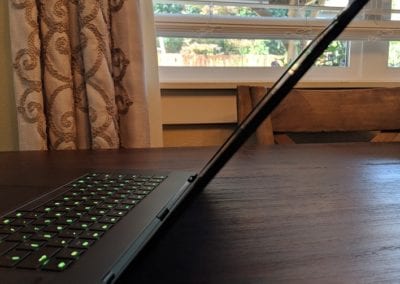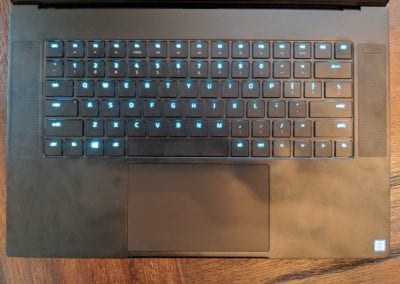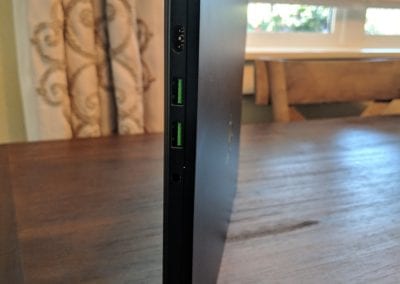At $2599, Razer has released the biggest ever refresh to their flagship gaming laptop, the Razer Blade. It now has modern bezels around an excellent 15.6″ display. The aluminum body chassis is as gorgeous as ever and packed inside is a GTX 1070 Max-Q. Razer has a 1060 Max-Q option available as well. I purchased the 1070 Max-Q laptop on day 1 and have no regrets. There is only one real issue I have with it, and that’s the keyboard layout. I’ll get to that below. Otherwise, I’m extremely impressed with the build, power, and quietness of the Razer Blade 15.
Specifications
- Model Number: RZ09-02386E92-R3U1
- CPU: 8th Generation Intel Core i7-8750H (2.8 GHz, 6-cores)
- Display: 15.6″ FHD (1080p) | 144 Hz | non-touch
- Graphics: Intel Integrated UHD 620 | NVIDIA GeForce GTX 1070 (8GB)
- Webcam: 720p HD
- RAM: 16GB DDR4 2400 MHz
- Storage: 512 PCIe SSD
- I/O:
- (1) USB Type-C (Thunderbolt 3)
- (3) USB 3.1 Type-A
- (1) HDMI
- (1) Mini DisplayPort
- (1) Microphone / Headphone Combo Jack
- Dimensions: 14″ x 9.25″ x 0.68″
- Weight: 4.63 lbs
Design and Build Quality
Generally, you won’t find a better built laptop that isn’t made by Apple. The machining of the aluminum chassis that shrouds the quality components inside the Blade 15 is absolutely immaculate. My device is smooth as butter on the outside. There was one hiccup that I was able to solve without submitting an RMA. The power port has 3 distinct pins and one of them bent. I’m sure it’s my fault, but I was disappointed that such an expensive machine can have this type of defect at such a young age. Aside from that snafu, the Blade feels exceptional to hold. It’s a premium device that will be sure to turn heads. Just know that it’ll attract a lot of fingerprints. I wish this came in the same gunmetal gray color as the 13.3″ Razer Blade Stealth.
The Display
The major highlight here is the 144Hz refresh rate. It’s a game-changer in-game, as well as just navigating around Windows. I’ve now found myself looking out for cell phones with high refresh rates, such as the Razer Phone (120Hz). Of course, this wouldn’t matter if the GPU couldn’t push games anywhere near 144Hz with 1080p resolution and high in-game settings. Thankfully the 1070 Max-Q model can do this. I had an opportunity to test the 1060 Max-Q model – don’t expect to be satisfied here. I think the $400 price increase is worth the upgrade to a 1070 Max-Q GPU.
Color representation is fantastic. I’m not a high-end photo editor, I merely dabble. I invited my business partner to test drive the Blade 15 – he’s a dynamic designer and expert PhotoShop user. He’s coming off a 2015 MacBook Pro and by the end of his test run, he declared his next laptop would be the Blade 15. That’s major praise that Razer doesn’t generally get. They’re well known for making laptops with high-end builds but the displays have always been behind. The previous generation Blade has a 14″ display and I imagine those were more expensive to procure at the quality level Razer was shooting for here with the 15.6″ display. Certainly, from a supply chain perspective, one would expect LCD/TN manufacturers to have perfected the quality on 15.6″ displays as they are way more common than 14″ displays. A wise move by Razer.
Gaming on the Blade 15 is a joy.
The Keyboard
Surprisingly, the one thing about the Blade 15 I would change is the keyboard layout. I can live with the key travel and the multimedia keys not being backlit. What I cannot live with is the positioning of the up-arrow. Oddly, Razer chose to displace the “Shift” and “/” keys by shoving the up-arrow between them. That may sound like a minor issue, but in reality it will trip you up more than you think. An acceptable workaround I’ve found is to remap the up-arrow to the “/” key. This isn’t ideal.
 Speaking of workarounds, I tweeted out a few weeks ago that you can better remember which function keys map to your favorite multimedia keys by leveraging Razer’s Synapse software to change the color of those function keys. As you can see in the image below, I’ve mapped F1, F2 and F3 to a yellow color – they control volume. I mapped F8 and F9 to green and they control screen brightness. Lastly, I mapped F10 and F11 to purple, and they control keyboard brightness.
Speaking of workarounds, I tweeted out a few weeks ago that you can better remember which function keys map to your favorite multimedia keys by leveraging Razer’s Synapse software to change the color of those function keys. As you can see in the image below, I’ve mapped F1, F2 and F3 to a yellow color – they control volume. I mapped F8 and F9 to green and they control screen brightness. Lastly, I mapped F10 and F11 to purple, and they control keyboard brightness.

Benchmarks
A gorgeous 144Hz display is worthless without something fun to throw at it. Gaming on the Blade 15 is a joy. Running on the native 1080p display, you can expect 100 FPS on nearly any modern title. I spend most of time on a 27″ external display that has a resolution of 1440p and a refresh of 144Hz. Without G-Sync enabled, I’m able to crush most modern games on this display. Personally, I do prefer gaming on the Blade’s display because I prefer to get more frames per second in this scenario. The following benchmarks use the native 1080p display on the Blade 15. You’ll see a range of FPS along with the highest observed fan noise.
- Kingdom Come: Deliverance: 65 to 85 | 54.1 dB
- Warhammer: Vermintide 2: 77 to 132 | 55.1 dB
- The Witcher 3: 144 | 51.8 dB
- Fortnite: 144 | 54.9 dB
Why it’s For Me
Fortunately, I’m at a point in my life where I can afford to spend a little extra for a quality laptop build that really doesn’t matter when it comes to performance. I know I can spend $500-$750 less and get a laptop that has the same components as the Blade 15 but is louder and has a plastic build. And, full disclosure, I got a sweet deal from BestBuy on this model which made the purchase decision easier. And now that I have it, I’ve found an excellent balance of performance and portability.



